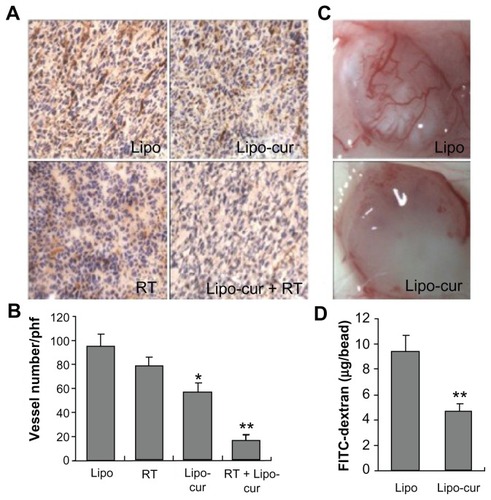Figures & data
Figure 1 Preparation and characterization of Lipo-cur. (A) Preparation scheme of Lipo-cur. (B) Size distribution of Lipo-cur. (C) Zeta potential of Lipo-cur. (D) Photographs of curcumin phosphate-buffered solution, Lipo-cur, and curcumin ethanol solution (from left to right). (E) Transmission electron microscopy image of Lipo-cur.
Abbreviations: Cur, curcumin; Lipo-cur, liposomal curcumin.
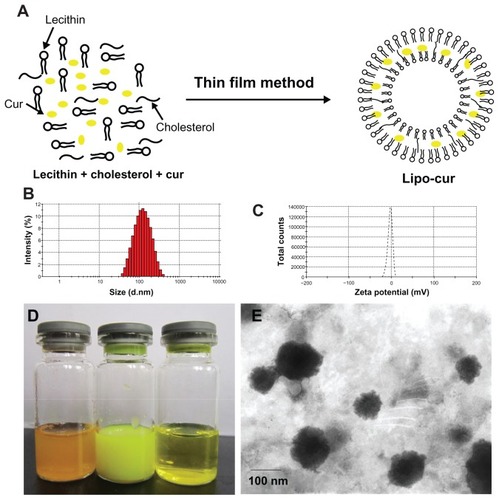
Figure 2 The effects of the treatment with Lipo-cur on body weight and life span. Normal C57BL/6J mice (7 weeks old, 20 mice per group) were treated intravenously with Lipo-cur (5 mg/kg), and NS was injected into each group through the tail vein. The injections were continued for 7 days, but mice were not challenged with tumor cells. Mice in each group were investigated for potential toxicity for 6 months. (A) There was no weight loss in the mice treated with Lipo-cur, compared with control groups (P > 0.05). The results are expressed as mean weight, and error bars represent ± standard error of the mean. (B) There was no decrease in life span in the mice treated with Lipo-cur, compared with the control groups (P > 0.05).
Note: Data represent percentage of survival at day 180 after the treatment.
Abbreviations: Lipo-cur, liposomal curcumin; NS, normal saline.
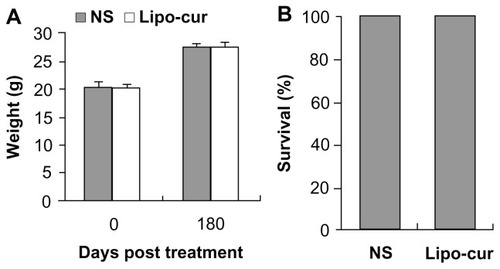
Figure 3 Lipo-cur inhibits the radiation-inducing pneumonitis in C57 mice. (A) The HE-stained images of histological sections. At weeks 1, 2, 4, and 6, histological sections were taken from lungs of irradiated C57BLL/6J and analyzed at ×100 magnification. The mice treated with Lipo-cur show a significant inhibition to the radiation-inducing pneumonitis. (B) The histology scores (see material and method) for the empty Lipo group and Lipo-cur group are shown for weeks 1, 2, 4, and 6 after radiation.
Notes: Data are from two representative lung sections per animal from three different animals per group. Data are mean ± standard error of the mean; *denotes P < 0.01 between groups.
Abbreviations: Lipo, liposome; Lipo-cur, liposomal curcumin; w, week.
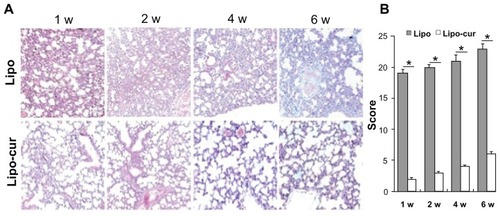
Figure 4 Lipo-cur inhibits radiation-inducing fibrosis in C57 mice. (A) Picric Acid-Sirius Red staining of lung tissue. Sections of the lung from radiated C57 mice at 3, 4, 5, and 6 weeks were analyzed for interstitial collagen content by Picric Acid-Sirius Red staining. Magnification: ×100. (B) Quantification of lung fibrosis by Sirius Red staining and subsequent semi-automated image analysis. Data are from two representative lung sections per animal from three different animals per group.
Notes: Data are mean ± standard error of the mean; *denotes P < 0.01 between groups.
Abbreviations: Lipo, empty liposome; Lipo-cur, liposomal curcumin; w, week.

Figure 5 Lipo-cur inhibits the activation of macrophages and downregulates the serum levels of pro-inflammatory cytokines. The inhibitory effect of Curcumin on activation of macrophages was detected first. (A) Curcumin inhibited the activity of NF-κB of macrophages. (B) Curcumin blocked the migration of macrophages (MCP-1, Cur: Cur+MCP-1, AS605240: AS605240+MCP-1). Then, the serum levels of both the Lipo and Lipo-cur group for IL-6, IL-8, TNF-α, and TGF-β cytokine concentration were measured at the first month of RP, mice in each group were bled for serum at the end of week 1, 2, 3, and 4 after being treated with Lipo or Lipo-cur. (C) The level of TGF-β from the Lipo-cur treatment group and the Lipo group. (D) The level of TNF-α from the Lipo-cur treatment group and the Lipo group. (E) The level of IL-8 from the Lipo-cur treatment group and the Lipo group. (F) The level of IL-6 from the Lipo-cur treatment group and the Lipo group.
Notes: Data are mean ± standard error of the mean; *denotes P < 0.05 between groups.
Abbreviations: Cur, curcumin; IL, interleukin; Lipo, empty liposome; Lipo-cur, liposomal curcumin; MCP, monocyte chemotactic protein; NF, nuclear factor; TGF, transforming growth factor; TNF, tumor necrosis factor.

Figure 6 Lipo-cur sensitizes cancer cells to RT. (A and B) C57BL/6J mouse tumor model was established by subcutaneous injection with 5 × 105 LL/2 cells. Mice (six mice in each group) were treated with 100 μg of Lipo-cur (▲) (intravenous route), RT (⋄), Lipo-cur (intravenous route) and RT (■), or Lipo solution alone (●). Significant difference was found in tumor volume (*denotes P < 0.05) between RT-curcumin group and those two methods alone. Points, mean (n = 8); bars, standard deviation. (C and D) Apoptosis of lung cancer cells was detected using TUNEL analysis. The percentage of apoptosis was determined by counting the number of apoptotic cells and dividing by the total number of cells in the field (five high power fields per slide).
Notes: The combined treatment with Lipo-cur and RT resulted in significantly increased apoptosis compared with that of other groups (*denotes P < 0.05, **denotes P < 0.01); bars, standard deviation; columns, mean.
Abbreviations: Lipo, empty liposome; Lipo-cur, liposomal curcumin; RT, radiotherapy; TUNEL, terminal deoxynucleotidyl transferase dUTP nick end labeling.
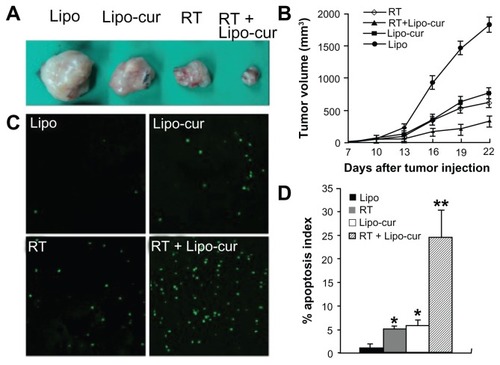
Figure 7 Inhibition of angiogenesis within tumors. (A and B) Frozen sections of tumor tissue were tested by immunohistochemical analysis of anti-CD31 antibody, and vascular density was quantified by counting the number of microvessels per high power field (×400). Vessel density of tumor tissues from combined treatment with Lipo-cur and RT indicated a decrease compared with the phosphate-buffered saline group (five high power fields per slide). (C and D) Alginate beads containing 1 × 105 LL/2 cells per bead were then implanted subcutaneously into the backs of mice. One group was treated with curcumin by intravenous injection once a day for 1 week, and one group was treated with normal saline. Beads were surgically removed 12 days later, and FITC-dextran was quantified. FITC-dextran uptake of beads from curcumin-treated mice showed a significant decrease compared with normal saline group.
Notes: *Denotes P < 0.05; **denotes P < 0.01; columns, mean; bars, standard deviations.
Abbreviations: FITC, fluorescein isothiocyanate; Lipo, empty liposome; Lipo-cur, liposomal curcumin; RT, radiotherapy.
